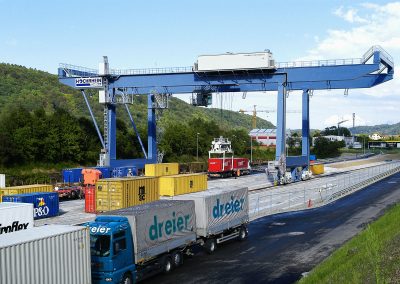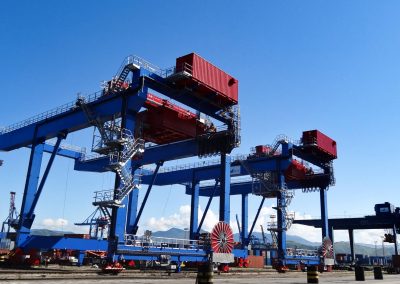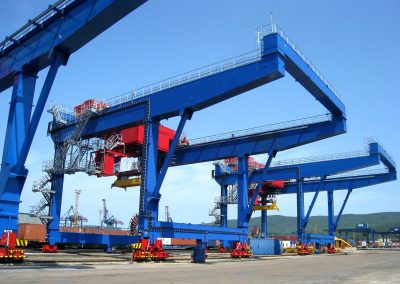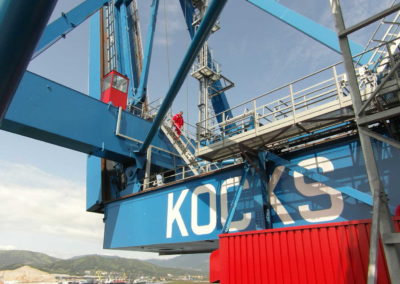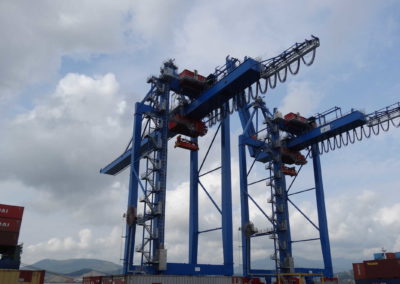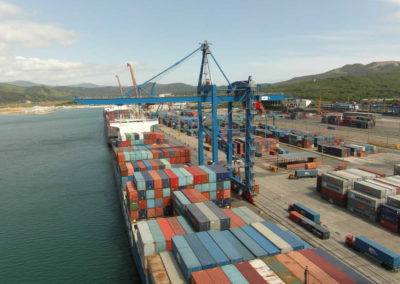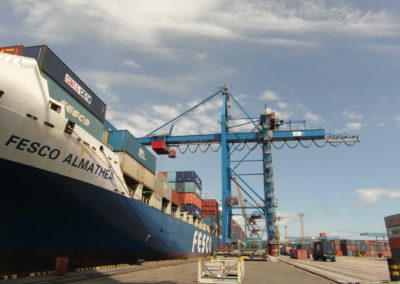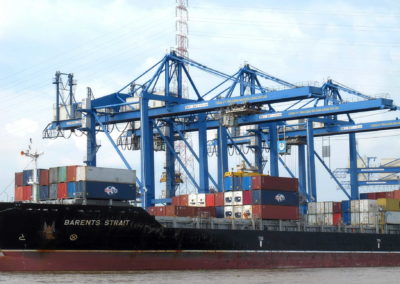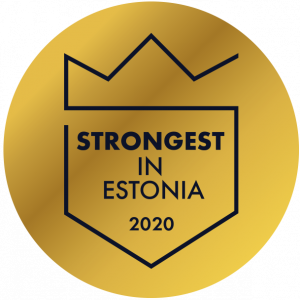Alekon Cranes > Handling Equipment > Container Cranes
CONTAINER CRANES
terminal server
RMG crane is an efficient solution for logistics terminals in the port. Continuous adaptation of transport and handling systems is required to increase the productivity of seaports and to manage ever-increasing cargo flows. Innovative solutions ensure an efficient intermediate storage of containers with optimized cargo access and with the needs of terminal logistic network.
Terminal Server is ideal for handling containers from railway tracks to road transport and vice versa. Terminal Server is the best solution for operations and storage in rear port areas.
The concept of placing the engine room, lifting mechanisms, and turning on the truck provides the crane clear positioning, accuracy of storage, high speed and the use of short ropes in the lifting mechanism.
The double lift mechanism is formed from a pair of identical winches connected by a cardan shaft. The traveling mechanism of the trolley is made of four individual drives. It guarantees high speeds and optimal traction. The slewing mechanism of the trolley consists of two frequency-controlled drivers and ensures accurate positioning in automatic mode.
Each wheel of gantry travelling mechanism is equipped with a drive. It minimizes slippage and provides excellent movement characteristics with speeds up to 150 m/min even on the curved tracks. Quick and secure access to all components and mechanisms of the structure is ensured by a system of platforms and ladders.
BOXER
BOXER is a container crane with systems of several running trolleys, extremely high speeds and capacity of up to 60 containers per hour. The crane perfectly combines two principles: maximum performance and minimum operating costs and achieved by a monoblock construction, designed with optimized stability and concept of placing the machinery house on a loading trolley.
The crane shows high performance even with a very narrow portal span, thanks to light box construction with diagonal reinforcement.
The trolley is the main component of the container crane, and its weight, size and operational characteristics directly affect performance. The speed of movement of the BOXER trolley can reach 230 m/min. The trolley is a mobile hoisting mechanism for the STS crane due to the concept of placing the machinery house on a trolley.
Very short ropes are used in the lifting mechanism. In this way, exceptional results are achieved positioning and optimum cargo control, high handling accuracy and work speeds. Short lifting ropes reduce the cost of spare parts and exclude frequent adjustment of the length. It significantly reduces the cost of maintenance. Ropes can be replaced with a raised seaside boom, which does not restrict the handling of vessels and does not block the berth.
The portal traveling mechanism consists of a system of trolleys, which are driven by one or a pair of wheels. Special mechanisms have been developed to withstand the duty in flooded areas.
The maximum safety of all components of the crane is provided by the electronic system of vibration damping and cargo control, high-speed emergency brakes and emergency actuator of the arrow lifting mechanism and a laser scanning system for arrow space to prevent collision with ship’s structures and cargo.
Intelligent service system SIS allows to visualize workflows, troubleshooting and complete remote diagnostics, including directly from the service center in Germany.
FEEDER SERVER
FEEDER SERVER is the ship-to-shore container crane, optimized for the vessels dimensions.
The trolley is the main component of the container crane. Its weight, size and operational characteristics directly affect the crane’s performance. The FEEDER SERVER trolley moves along the lower console profile. Each wheel is equipped with an individual drive and coated in a plastic bandage. It significantly reduces the wear of the structure, vibration and noise from movement.
The console system consists of a sea, rear and bridge girder, monobloc design. This is the ideal solution for low weight and high rigid booms. There are the premises for lifting mechanisms, sea console lifting mechanisms and electrical room on the upper part of the bridge girder.
The box-type portal is designed with the highest load-bearing capacity when working on bending and twisting. The twin-diagonal construction with two horizontal girders makes the crane cross-section very rigid and prevents the crane from swinging in the direction of the trolley.
The lifting/lowering mechanism locates in a separate room on the bridge girder. The mechanism consists of two drives connected by a shaft. In case of failure of one of the drivers, the operation can be easily completed with the help of a functioning one. The sea console lift is also equipped with an auxiliary drive that allows to complete the operation even if the main console fails. Both mechanisms are equipped with hydraulic brakes in case of emergency or power failure.
There is also a possibility to use a universal movement mechanism, which combines the pneumatic and rail stroke. FEEDER SERVER can be run on pneumatic wheels in areas that are not equipped with crane runways. Each wheel is installed with a separate power source and controlled hydraulically. It allows the product to move and turn in any direction. In the operating position, the crane lowers to load-distributing stops and trolleys. The crane uses the possibility of a rail stroke for quick and effective positioning on the pier.
FEEDER SERVER MOBILE is equipped with two diesel generators. It allows to operate without an external power supply for up to several days.
